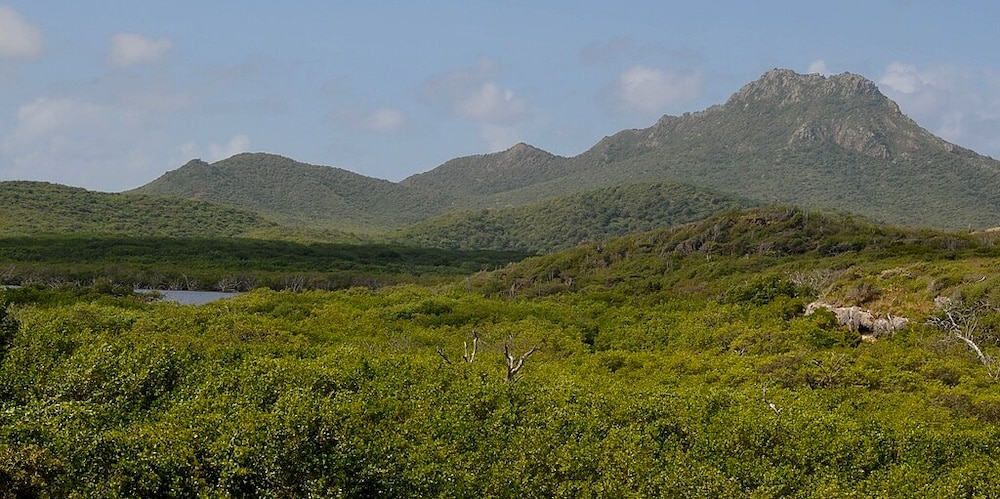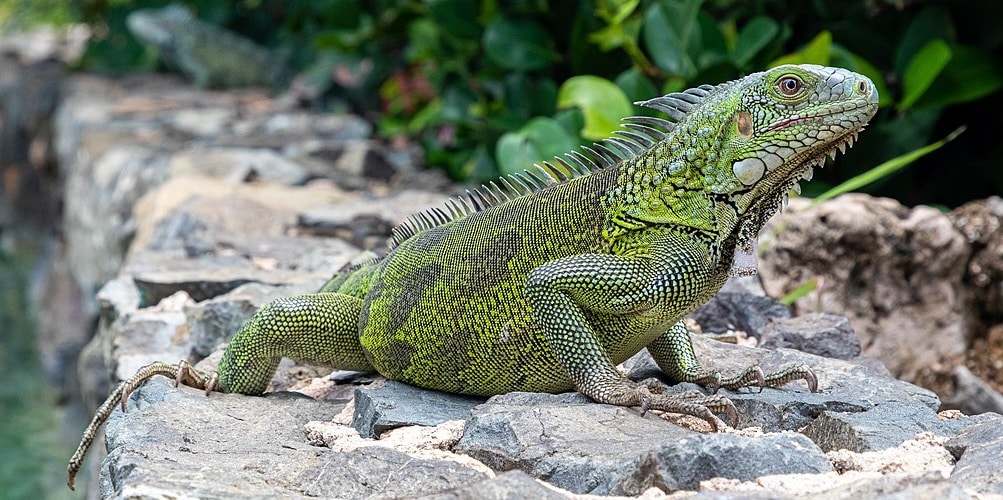Curaçao

Curaçao is a constituent island country within the Kingdom of the Netherlands in the southern Caribbean Sea, specifically the Dutch Caribbean region, about 65 km (40 miles) north of Venezuela. It includes the main island of Curaçao and the much smaller, uninhabited island of Klein Curaçao (Little Curaçao). Curaçao has a population of around 185,000 people, with an area of 444 km2 (171 square miles); its capital is Willemstad. Together with Aruba and Bonaire, Curaçao forms the ABC islands. Collectively, Curaçao, Aruba, and other Dutch islands in the Caribbean are often called the Dutch Caribbean. It is the largest of the ABC islands in terms of area and population, as well as the largest in the Dutch Caribbean.
Curaçao, lies on the continental shelf of South America featuring a hilly topography, with its highest point reaching 1,220 feet above sea level named Christoffelberg. Curaçao has diverse range of beaches from coastline’s bays, inlets, lagoons, seasonal lakes, rough seas on its northern shore, and a freshwater spring. In addition, it has upwelling which is an oceanographic phenomenon that involves wind-driven motion of dense, cooler and nutrient-rich water from deep ocean moving towards the ocean surface, contributing to the source of natural minerals, thermal conditions, and seawater used in hydrotherapy and mesotherapy, making the island one of many balneo-climateric areas in the region. Furthermore, off the southeast coast of the main island of Curaçao lies the tiny uninhabited Isle of Klein Curaçao, which boasts a long, stretched beach.

Christoffelberg – ©Jerrye & Roy Klotz via Wikimedia Commons
Curaçao has a semiarid climate with a dry season from January to September and a wet season from October to December. The temperatures are relatively constant throughout the year. The trade winds cool the air during the day and warm it during the night. The coldest month is January with an average temperature of 26 °C and the warmest month is September with an average temperature of 29 °C. The year’s average maximum temperature is just over 31 °C, and the average minimum temperature is just over 25 °C. Curaçao lies outside the hurricane belt, but is still occasionally affected by hurricanes.
Birding Curaçao
Curaçao’s flora differ from typical tropical island vegetation. Guajira-Barranquilla xeric scrub is the most notable, with various forms of cacti, thorny shrubs, evergreen, and watapana trees Libidibia coriaria, which are characteristic of the ABC islands. Brassavola nodosa is a drought-tolerant species of Brassavola, one of the few orchids present in the ABC islands. Cacti include Melocactus and Opuntia species such as Opuntia stricta.

Green Iguana Iguana iguana – ©Aatu Dorochenko via Wikimedia
The country is semi-arid, and as such has not supported the numerous tropical species associated with rainforests. Other than field mice, small rabbits, and cave bats, Curaçao’s only notable mammal is the white-tailed deer, probably introduced by man in prehistoric times; the majority inhabit Chistoffel Park. There are several species of iguana, found lounging in the sun across the island. Unlike many islands that gave up the practice, iguanas are still hunted and eaten. Along the west end of the island’s north shore are several inlets with breeding turtles, which are protected by the park system in Shete Boka Park and can be visited accompanied by park rangers.

Curaçao Shore, Shete Boka National Park – ©Daniel Alfaro C. via Wikimedia Commons
280 species of avifauna have been recorded, although resident species are a much smaller number. However, dozens of bird species can be found on the island such as two hummingbird species (Blue-tailed Emerald and Ruby-topaz), bananaquits, Yellow Orioles, terns, herons and even flamingos make their homes near ponds or in coastal areas. The Troupial is common on Curaçao as are Tropical Mockingbirds. Other species regularly encountered in gardens include Black-faced Grassquit, Brown-throated Parakeet, Rufous-collared Sparrow, White-tipped Dove and Blue-tailed Emerald. There are four raptors, American Kestrel, White-tailed Hawk, Barn Owl and Crested Caracara. Black vulture has recently begun to colonise. Near shorelines, Brown Pelicans feed. There are, too, other seabirds including cormorants and several types of gulls such as Laughing Gulls and terns including Least and Royal Terns. Species number swell during migration periods.
Christoffel Mountain lies in the reserved wildlife park, Curaçao Christoffelpark, and can be explored by car, bike, horse or on foot. Several trails have been laid out. There are also Saliñas, salt marshes where flamingos rest and feed, along with migratory waders and heron species. 24km (15 miles) off the coast of Curaçao, to the southeast, lies the small, uninhabited island of Klein Curaçao (Little Curaçao).
-
Wikipedia®
GNU Free Documentation License
https://en.wikipedia.org/wiki/Curaçao
-
Number of bird species: 281
(As at March 2025)
-
Avibase
PDF ChecklistThis checklist includes all bird species found in Curaçao , based on the best information available at this time. It is based on a wide variety of sources that I collated over many years. I am pleased to offer these checklists as a service to birdwatchers. If you find any error, please do not hesitate to report them. -
E-Bird
PDF ChecklistThis checklist is generated with data from eBird (ebird.org), a global database of bird sightings from birders like you. If you enjoy this checklist, please consider contributing your sightings to eBird. It is 100% free to take part, and your observations will help support birders, researchers, and conservationists worldwide. -
Wikipedia
Annotated ListThis is a list of the bird species recorded in Curaçao. The avifauna of Curaçao has 217 confirmed species, of which 13 have been introduced by humans and 75 are rare or vagrants. An additional four species are hypothetical (see below). None are endemic.
-
Birds of Aruba, Bonaire, and Curaçao: A Site and Field Guide
| By Jeffrey V Wells, Allison Childs Wells & Robert Dean | Comstock Publishing Associates | 2017 | Paperback | 474 pages, 59 plates with colour illustrations; colour photos, colour maps | ISBN: 9781501701078 Buy this book from NHBS.com -
Birds of Aruba, Curacao and Bonaire
| By Bart De Boer, Eric Newton & Robin Restall | Helm | 2020 | Paperback | 176 pages | 70 colour plates | 5 colour photos | 4 colour maps | ISBN: 9781472982568 Buy this book from NHBS.com -
Checklist of the Birds of Aruba, Curacao and Bonaire South Caribbean
| By TG Prins, JH Reuter, AO Debrot, J Wattel and V Nijman | NOU | Hardback | 268 pages, maps, colour photos | ISBN: #187100 Buy this book from NHBS.com -
The Birds of the West Indies
| By Guy M Kirwan, Anthony Levesque, Mark W Oberle & Christopher J Sharpe | Lynx Edicions | 2019 | 400 pages, 1600+ colour illustrations, 650+ colour distribution maps | ISBN: 9788416728176 Buy this book from NHBS.com

Birds of the West Indies
AndroidThis bilingual, mobile field guide for the West Indies includes all 415 bird species of Puerto Rico and the northeastern Lesser Antilles: Virgin Islands, Anguilla, Saint Martin (Sint Maarten), Antigua and Barbuda, Montserrat, Sint Eustatius, Saint Kitts and Nevis, Saint Barthélemy (St. Barts), and Saba.
Birds of the West Indies
Apple iOS |Explore the vibrant Caribbean islands with Birds of the West Indies – your pocket guide to Caribbean birdwatching!Organisations-
Backyard Birding Curacao
Facebook PageTo stimulate attracting and watching more wild birds in Curacao Backyards -
Birding Curaçao - Curaçao ornithology group
Facebook PageGroup for all the bird lovers on and off Curaçao interested in bird watching, bird research and bird photography. -
Curaçao Nature Conservation (CuNaCo)
WebsiteCuraçao Nature Conservation is an independent campaigning organization that focuses on creative communication to raise awareness on environmental and social problems while promoting solutions that are essential to a sustainable and peaceful future. -
Dutch Caribbean Nature Alliance (DCNA)
WebsiteThe largest and most densely populated of the Dutch Caribbean’s six island...
Reserves-
*Protected areas of Curaçao
InformationSatellite ViewInteractive list of parks etc. -
IBA Muizenberg
InformationSatellite ViewMuizenberg comprises a 150 ha wetland area, including an intermittent shallow lake (Muizenberg) and a smaller pond (Kaya Fortuna). -
NP Christoffelpark
WebsiteSatellite ViewChristoffelpark is a national park, protected nature area and tourist attraction at the north-western end of the island of Curaçao surrounding Christoffelberg (Mt Christoffel).
Sightings, News & Forums-
eBird
SightingseBirding This Month
Guides & Tour Operators-
Bird Watching Curacao
Guiding...a limited number of private bird-watching trips. Fill in the form... -
Birding Guide Curacao
GuidingYour Personal Birding Guide in Curaçao -
Christoffel National Park
GuidingIn the park it is possible to see many of the 263 bird species, which have been recorded on Curacao. 57 are resident birds for the island. The others are visiting Curacao during their annual migration. -
KleinCuracao.deals
PelagicExperience Curacao’s Avian Wonders with Our Exclusive Private Charters
Trip Reports-
2006 [01 January] - John van der Woude
ReportPhotos and site locales
Other Links-
Bird Watching Curaçao
InformationAll about the birds, bird identification & bird watching trips in Curaçao!
Fatbirder - linking birders worldwide...
Skip to content
